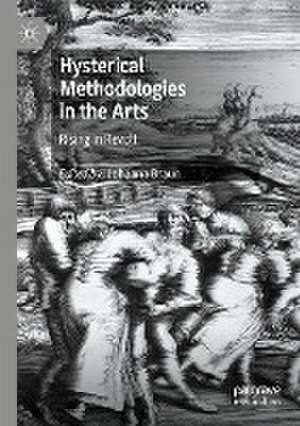Hysterical Methodologies in the Arts: Rising in Revolt
Editat de Johanna Braunen Limba Engleză Paperback – 20 iun 2022
| Toate formatele și edițiile | Preț | Express |
|---|---|---|
| Paperback (1) | 729.06 lei 6-8 săpt. | |
| Springer International Publishing – 20 iun 2022 | 729.06 lei 6-8 săpt. | |
| Hardback (1) | 734.27 lei 6-8 săpt. | |
| Springer International Publishing – 19 iun 2021 | 734.27 lei 6-8 săpt. |
Preț: 729.06 lei
Preț vechi: 889.09 lei
-18% Nou
Puncte Express: 1094
Preț estimativ în valută:
139.50€ • 145.67$ • 115.20£
139.50€ • 145.67$ • 115.20£
Carte tipărită la comandă
Livrare economică 15-29 aprilie
Preluare comenzi: 021 569.72.76
Specificații
ISBN-13: 9783030663629
ISBN-10: 3030663620
Ilustrații: XXVI, 380 p. 58 illus., 39 illus. in color.
Dimensiuni: 148 x 210 mm
Greutate: 0.49 kg
Ediția:1st ed. 2021
Editura: Springer International Publishing
Colecția Palgrave Macmillan
Locul publicării:Cham, Switzerland
ISBN-10: 3030663620
Ilustrații: XXVI, 380 p. 58 illus., 39 illus. in color.
Dimensiuni: 148 x 210 mm
Greutate: 0.49 kg
Ediția:1st ed. 2021
Editura: Springer International Publishing
Colecția Palgrave Macmillan
Locul publicării:Cham, Switzerland
Cuprins
1. Introduction: Searching for Methods in this Madness; Johanna Braun.- 2. L’Arc de Cercle, or the Movement of Modernism (1620-2020); Nathan J. Timpano.- 3. Hysterias in Pictures; Anna Furse.- 4. From “Private Theatres Onstage” to Anti-Hysterical Performances: Reclaiming the Feminist Interest in Hysterical Performances since the 1990s; Tanya Augsburg.- 5. State of Anxiety: Hysterical Studies for Reproduction Struggles; Elke Krasny.- 6. Hysteria, Turning a Diagnosis into a Call; Mette Kjærgaard Præst.- 7. To Arc, and Other Studies on Hysterical Gesturing; Cindy Rehm and Johanna Braun.- 8. The Other Self of Imagination: Cindy Sherman’s Hysterical Performance; Elisabeth Bronfen.- 9. Hysterical Representation in the Art of Mary Sibande; Anne Scheffer, Ingrid Stevens and Amanda du Preez.- 10. A Storm in a Teacup, and other minor melodramas: Narratives of Containment and Excess in cultured colonies / colonial cultures; Leora Farber.- 11. Making Ghosts Heard; Laura González.- 12. Hysterical Aesthetics in Contemporary Performance: Theatre, Dance, Voice; Jonathan W. Marshall.- 13. H. Y. S. T. et al, on Archiving Hysteria’s Past in the Present; Shana Lutker and Johanna Braun.- 14. Male Hysteria and the Archive: An Auto-Ethnographic Reflection; Thomas Ballhausen.- 15. Notes on Hysteria in and as Arts-based Research; a Case Study; Johanna Braun.- 16. Dora with Medusa: Is Hysterical Writing a Subversive Revolution?; Elisabeth Schäfer.- 17. Lecture Performance: On Truth and its Relation to the Cellar Regions of the Body; Arno Boehler and Susanne Valerie Granzer.- 18. Via Telefaune; a Phone Call with Hélène Cixous; Helene Cixous and Elisabeth Schäfer.
Notă biografică
Johanna Braun is an artist, scholar, curator, and Principle Investigator of the postdoctoral research project “The Hysteric as Conceptual Operator” [J 4164-G24], sponsored by the Austrian Science Funds [FWF], and situated at the University of California, Los Angeles, Stanford University and the University of Vienna (2018-2020).
Textul de pe ultima copertă
“I recommend this book warmly to all readers interested in the current state of scholarship on hysteria, art, and politics. It is an exciting and timely book with a wonderful range of work, with considerable erudition, innovative theory and artwork.”
—Professor Valerie Walkerdine, Cardiff University, UK
Hysteria is alive and well in our present time and is apparently spreading contagiously: in particular, the second decade of the twenty-first century has shown an increased interest in the term. A quick web search opens the gates to endless swathes of discussions on hysteria, covering almost every aspect of public discourse. The arts seem conspicuously involved in and engaged with this hysterical discourse. Surprisingly, while the strong academic interest in hysteria throughout the twentieth century and, most prominently, at the turn of the century is well-known and much-discussed, the study of how these discourses have continued into twenty-first-centuryart practices addresses what is effectively an academic blind spot. It is the aim of this volume to illustrate how hysteria was already well-established within the arts alongside and, at times, even separately from much-covered medical studies, and reveal how current artistic practices continue a century spanning cross-fertilization between hysteria and the arts.
Johanna Braun is an artist, scholar, curator, and Principle Investigator of the postdoctoral research project ‘The Hysteric as Conceptual Operator’ [J4164- G24], sponsored by the Austrian Science Fund [FWF], and situated at the University of California Los Angeles, Stanford University, and the University of Vienna (2018–2020).
—Professor Valerie Walkerdine, Cardiff University, UK
Hysteria is alive and well in our present time and is apparently spreading contagiously: in particular, the second decade of the twenty-first century has shown an increased interest in the term. A quick web search opens the gates to endless swathes of discussions on hysteria, covering almost every aspect of public discourse. The arts seem conspicuously involved in and engaged with this hysterical discourse. Surprisingly, while the strong academic interest in hysteria throughout the twentieth century and, most prominently, at the turn of the century is well-known and much-discussed, the study of how these discourses have continued into twenty-first-centuryart practices addresses what is effectively an academic blind spot. It is the aim of this volume to illustrate how hysteria was already well-established within the arts alongside and, at times, even separately from much-covered medical studies, and reveal how current artistic practices continue a century spanning cross-fertilization between hysteria and the arts.
Johanna Braun is an artist, scholar, curator, and Principle Investigator of the postdoctoral research project ‘The Hysteric as Conceptual Operator’ [J4164- G24], sponsored by the Austrian Science Fund [FWF], and situated at the University of California Los Angeles, Stanford University, and the University of Vienna (2018–2020).
Caracteristici
Brings together some of the leading scholars working in the field today, including Elisabeth Bronfen, Hélène Cixous, and Anna Furse Examines the cultural relevance of the representation of hysteria in contemporary media Analyzes hysteria as a cultural phenomenon in historical context and as an analytical concept from a variety of disciplines
